“Global Fog Computing Market to reach a market value of 8.9 Billion by 2031 growing at a CAGR of 50.4%”
The Global Fog Computing Market size is expected to reach $8.9 billion by 2031, rising at a market growth of 50.4% CAGR during the forecast period.
This strong performance can be attributed to the growing demand for real-time data processing and automation within manufacturing facilities. Fog computing's ability to process data locally allows for enhanced operational efficiency, improved predictive maintenance, and seamless communication between machines, making it a crucial technology for advancing Industry 4.0 and smart factories. Thus, the smart manufacturing segment garnered 27% revenue share in the fog computing market in 2023.
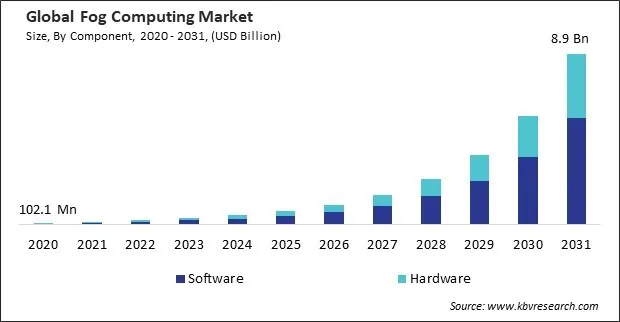
The major strategies followed by the market participants are Partnerships as the key developmental strategy to keep pace with the changing demands of end users. For instance, In January, 2024, IBM Corporation partnered with American Tower, a wireless infrastructure services provider, to deploy a hybrid, multi-cloud computing platform at the edge. This partnership would enhance enterprise flexibility by leveraging American Tower’s infrastructure with IBM’s hybrid cloud capabilities. Additionally, In May, 2023, Cisco Systems, Inc teamed up with NTT Ltd., an IT infrastructure solutions provider, to develop solutions for operational efficiencies for their joint customers. The two companies would serve their joint customers with IoT services to accelerate their operational efficiencies.
Based on the Analysis presented in the KBV Cardinal matrix; Microsoft Corporation is the forerunner in the Fog Computing Market. In April, 2023, Microsoft Corporation expanded its partnership with Cognizant, an American IT company, to provide IoT solutions across the healthcare industry. The partnership would allow the two companies to provide their customers with interoperability solutions and claims management. Companies such as Amazon Web Services, Inc., IBM Corporation, and Cisco Systems, Inc. are some of the key innovators in Fog Computing Market.
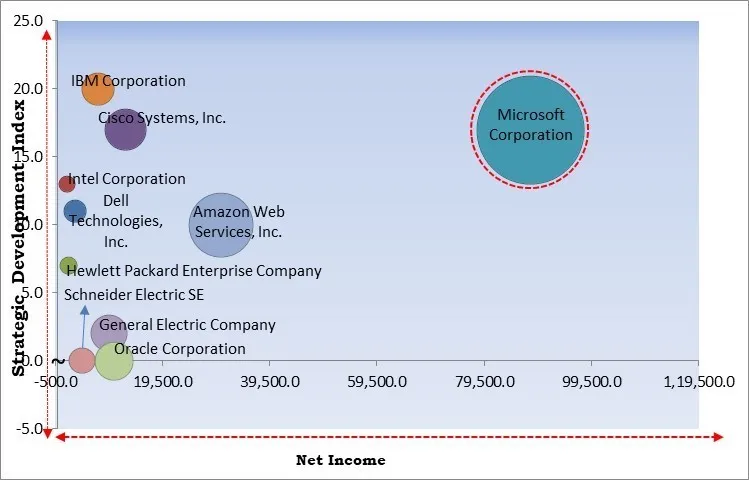
It enhances the overall performance of IoT networks by distributing the computational load, preventing bottlenecks, and ensuring smoother operation of the connected devices. Therefore, fog computing will become increasingly critical in the real-time management and processing of the enormous quantities of data that IoT devices generate as the number of devices increases.
Additionally, fog computing enables cities to respond promptly to challenges by facilitating real-time data processing at the periphery, thereby enhancing the quality of life of residents and optimizing resource utilization. Therefore, such smart city initiatives across the globe are driving demand for fog computing.
Although it offers distinct advantages, such as reduced latency, improved efficiency, and real-time data processing, setting up the necessary infrastructure demands a substantial financial outlay. Companies looking to integrate fog computing into their operations must invest in a range of hardware, including edge devices, sensors, and processing units that can handle the distributed nature of fog architecture. The costs associated with energy consumption can also be significant, especially in sectors that rely heavily on real-time data processing, such as manufacturing, logistics, and healthcare. Thus, without cost-effective solutions, these financial barriers may slow the adoption rate of fog computing.
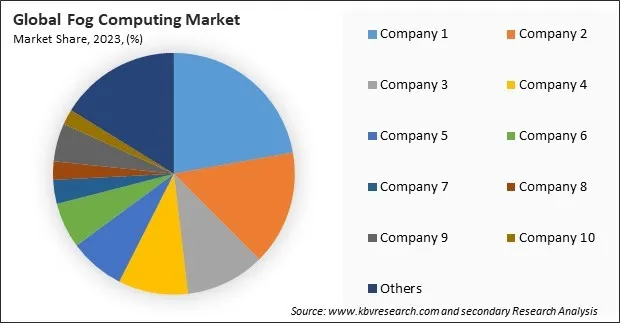
The leading players in the market are competing with diverse innovative offerings to remain competitive in the market. The above illustration shows the percentage of revenue shared by some of the leading companies in the market. The leading players of the market are adopting various strategies in order to cater demand coming from the different industries. The key developmental strategies in the market are Partnerships, Collaborations & Agreements.


The hardware segment is further divided into gateways, routers & switches, IP video cameras, sensors, and micro data sensors. The gateways segment acquired 32% revenue share in the market in 2023. This is largely due to gateways' pivotal role in bridging IoT devices with cloud or fog computing systems, enabling efficient data aggregation and processing at the network edge.
On the basis of application, the market is classified into connected vehicles, smart grids, smart cities, connected healthcare, smart manufacturing, and others. The smart grids segment procured 23% revenue share in the market in 2023. Smart grids rely heavily on real-time data processing to monitor energy consumption, manage distribution, and maintain grid stability.
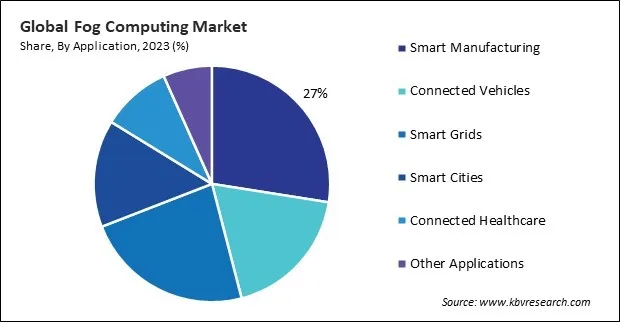
Based on component, the market is bifurcated into hardware and software. The hardware segment procured 36% revenue share in the market in 2023. The segment's expansion can be ascribed to the growing number of edge devices, sensors, and gateways that are used to support fog computing infrastructures.
Free Valuable Insights: Global Fog Computing Market size to reach USD 8.9 Billion by 2031
Region-wise, the market is analyzed across North America, Europe, Asia Pacific, and LAMEA. The Europe segment witnessed 28% revenue share in the fog computing market in 2023. Europe's focus on industrial automation and strong government initiatives supporting smart grids and smart city projects contributed to the region's market growth.
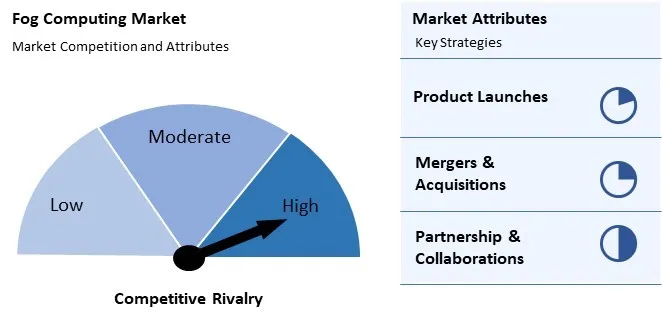
The Fog Computing Market is highly competitive, driven by the demand for low-latency processing and improved data management across IoT devices. Key attributes include scalability, security, and interoperability, with a focus on edge analytics and real-time data processing. Partnerships and collaborations are common strategies to enhance service offerings and expand market reach. The increasing need for smart city solutions and industrial automation further intensifies competition, making innovation and customer.
| Report Attribute | Details |
|---|---|
| Market size value in 2023 | USD 367.4 Million |
| Market size forecast in 2031 | USD 8.9 Billion |
| Base Year | 2023 |
| Historical Period | 2020 to 2022 |
| Forecast Period | 2024 to 2031 |
| Revenue Growth Rate | CAGR of 50.4% from 2024 to 2031 |
| Number of Pages | 272 |
| Tables | 393 |
| Report coverage | Market Trends, Revenue Estimation and Forecast, Segmentation Analysis, Regional and Country Breakdown, Competitive Landscape, Market Share Analysis, Porter’s 5 Forces Analysis, Company Profiling, Companies Strategic Developments, SWOT Analysis, Winning Imperatives |
| Segments covered | Component, Application, Region |
| Country scope |
|
| Companies Included | Cisco Systems, Inc., Microsoft Corporation, Dell Technologies, Inc., Intel Corporation, Amazon Web Services, Inc. (Amazon.com, Inc.), IBM Corporation, General Electric Company, Schneider Electric SE, Hewlett Packard Enterprise Company and Oracle Corporation |
By Component
By Application
By Geography
This Market size is expected to reach $8.9 billion by 2031.
Increased adoption of IoT devices are driving the Market in coming years, however, Security and privacy concerns in fog computing restraints the growth of the Market.
Cisco Systems, Inc., Microsoft Corporation, Dell Technologies, Inc., Intel Corporation, Amazon Web Services, Inc. (Amazon.com, Inc.), IBM Corporation, General Electric Company, Schneider Electric SE, Hewlett Packard Enterprise Company and Oracle Corporation
The expected CAGR of this Market is 50.4% from 2024 to 2031.
The Software segment is leading the Market by Component in 2023; thereby, achieving a market value of $5.7 billion by 2031.
The North America region dominated the Market by Region in 2023, and would continue to be a dominant market till 2031; thereby, achieving a market value of $3.6 billion by 2031.
Our team of dedicated experts can provide you with attractive expansion opportunities for your business.
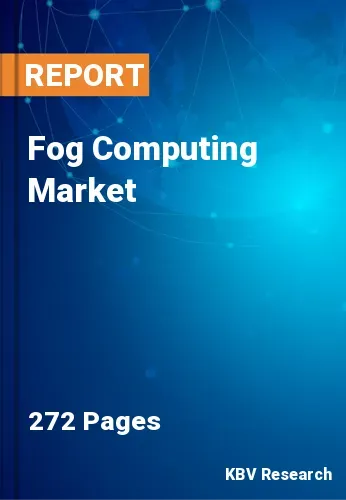
 Drivers
Drivers
 Restraints
Restraints
 Opportunities
Opportunities
 Challenges
Challenges
